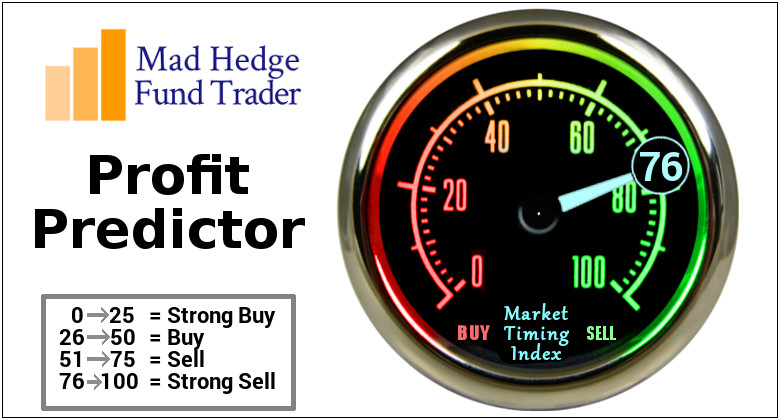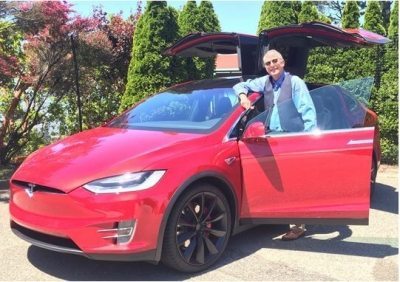When John identifies a strategic exit point, he will send you an alert with specific trade information as to what security to sell, when to sell it, and at what price. Most often, it will be to TAKE PROFITS, but, on rare occasions, it will be to exercise a STOP LOSS at a predetermined price to adhere to strict risk management discipline.


Trade Alert - (TSLA) – EXPIRATION-TAKE PROFITS
EXPIRATION of the Tesla (TSLA) December 2020 $392-$420 in-the-money vertical Bull Call spread at $28.00
Closing Trade
12-18-2020
expiration date: December 18, 2020
Portfolio weighting: increase from 40% down to 30%
Number of Contracts = 4 contracts
This option spread does not expire for two more days.
However, I have a record eight positions going into the Friday, December 18 option expiration so I am going to start closing these out early so as not to overload you, or my back office.
Provided that Tesla does not fall $194.9 over the next two days, the Tesla (TSLA) December 2020 $392-$420 in-the-money vertical Bull Call spread will expire at its maximum value of $28.00.
That means you get to earn $2,200, or 24.44% in 21 trading days. Well done, and on to the next trade.
You don’t have to do anything with this expiration.
Your broker (are they still called that?) will automatically use your long position to cover your short position, canceling out the total holdings.
The entire profit will be credited to your account on Monday morning December 21 and the margin freed up.
Some firms charge you a modest $10 or $15 fee for performing this service.
I am inclined to give Tesla a rest here, keeping my sole January long position. Once the company joins the S&P 500 on December 21, we may see a round of profit-taking.
It seems that most of the Index funds were trapped out of Tesla and were forced to buy a big chunk of it by yearend. That is what took the stock to a new all-time high of $650. Because of S&P’s operating profit requirements, most traders thought this wouldn’t take place until well into 2021 or 2022.
Most of these firms wouldn’t be caught dead owning Tesla, as it is too volatile and considered the preeminent “green” stock. But the Index is the Index.
What is also happening is that the oil companies that financed massive shorts in Tesla stock in an effort to drive it bankrupt are now suffering gigantic losses and are at risk of going under themselves. The irony is sweet.
I very rarely take on a six-fold position. The last time I did it was with Tesla and I made a fortune.
Here we go again!
Tesla also seems to be the only stock in the market that is immune to bad news on the pandemic front.
This opens up new categories of institutional investors for Elon Musk’s dream come true, such as the $4.5 trillion in (SPX) index funds, which are now required to buy it. Add up all the mandated buying that must take place by year-end to meet regulatory requirements and it’s something like $80 million.
It gives the (SPX) more of a technology bent. S&P finally got past the issue of most of the company’s profits coming from ZEV, or green credits.
Tesla is begging to break out to new all-time high as it relentlessly takes over the fast-growing global electric vehicle market. For a catalog of the reasons why, please read my recent in-depth research report on the company below.
This was a bet that Tesla (TSLA) would not trade below $420 by the December 18 option expiration day in 21 trading days.
Here are the specific trades you need to close out this position:
Expiration of 4 December 2020 (TSLA) $392 calls at….......……$222.90
Expiration of short 4 December 2020 (TSLA) $420 calls at…...$194.90
Net Proceeds:…………................…...........…….………..………….…..$28.00
Profit: $28.00 - $22.50 = $5.50
(4 X 100 X $5.50) = $2,200 or 24.44% in 21 trading days.

See below my most recent research report on Tesla.
Tesla Tales
When a guest asked me to name a clear ten-bagger stock for the coming decade at the Mad Hedge Lake Tahoe Conference, I didn’t hesitate.
It was Tesla (TSLA).
At long last, investors are perking up and taking notice of the Fremont, California-based electric car manufacturer whose shares have been trapped in a highly volatile three-year trading range.
Tesla was the top-performing stock in the market over the last five months, soaring some 96% from $178 to $356.
Of course, ramping up production to over 450,000 units last year has given Tesla new respectability. Elon Musk pulled this off by building a huge tent in the Tesla Fremont parking lot and constructing a third assembly line, all in three short weeks.
He also used workers to replace the German Kuka and Japanese Fanuc robots which had a bad habit of breaking down during peak production. Output instantly leaped by 50%. It was one of the most aggressive and brilliant moves in business history.
Total production of Tesla’s since the 2010 inception of Model S-1 manufacturing reached 1 million during January 2020.
They are also encouraged by the appointment of Larry Ellison to the board of directors, a new supervising adult, and Musk friend. The short answer is that they will go up a lot, certainly after they broke through the old $394 high.
The sky is now the limit. Immediate forecasts have been universally raised to $1,200. After that, you can target $2,500 and then $5,000.
I was one of the first buyers of Tesla shares at $16 ½ in the aftermath of its IPO debacle during the Great Recession. I bought one of the first Tesla Model S-1’s, chassis no. 125, in 2010.
I’ve toured the Fremont factory countless times and have even taken a couple apart after I totaled them. I have Boy Scout troops and middle school science classes there. Suffice it to say that I know which end of a Tesla to hold upwards.
So it’s time for all of us to become more familiar with this vehicle that is 10 years from the future. I have been driving the latest Model X with every possible upgrade for the past year, which included the hardware for the point-to-point autopilot that will be activated in two years.
What I learned was amazing.
While the media focus is overwhelmingly on the 1,100-pound liquid-cooled lithium-ion battery, it is in fact one of the least important aspects of Elon Musk’s vision.
The car has 80% fewer parts than any other modern vehicle. That enables Tesla to cut production costs to the extent that it can afford to install a $10,000 battery in every Model 100D model shipped.
And here’s the interesting part. Since I started driving electric cars 11 years ago with the Nissan Leaf, the battery cost has cratered from $1,000 to $120 per kilowatt-hour. With the completion of the second Gigafactory in Sparks, NV, that cost will drop well below $100/kWh. That’s what will make Tesla’s low-end Tesla 3 to become profitable….and go global.
I am constantly learning new things about these elegant, well thought out machines. When I picked up my last one, the configuration was all wrong. No problem. After 30 minutes in the shop, it came back to the specifications I ordered.
It was then I realized that all the options and upgrades are modular and can be snapped, fitted, or screwed on in minutes. That greatly simplified production, distribution, and versatility.
The downside is that Tesla is expanding so fast that the man who sold it to me knew virtually nothing about the car, being a former Mercedes salesman, and REGISTERED THE CAR IN THE WRONG STATE. But then it’s tough to find any good people today in this full-employment economy.
Ever the scientist, I designed a series of grueling experiments to put my “X” through during my Christmas vacation at Lake Tahoe.
I was able to make the 200 miles from the San Francisco Bay Area to Lake Tahoe on a single charge, a vertical climb of 7,200 feet. Better to stop at the Safeway in Truckee, CA which offers 16 superchargers, do your grocery shopping, and get a top-up.
Having flown small aircraft across the Atlantic, I am somewhat sensitive to range considerations. I once flew a Cessna 340 from Newfoundland to Iceland. Over Greenland, the wind shifted from a 50 miles tailwind to a 50 miles headwind, but we didn’t know it because GPS was not yet available to civilians. I ended up landing in Reykjavik with 15 minutes of fuel. An Icelandic Air Force helicopter escorted me the last 20 miles as a precaution.
And by the way, it is impossible to put on an orange survival floatation suite while you’re flying a plane. But I diverge.
I drove from the Tesla Supercharger station at the Atlantis Hotel & Casino in Reno, NV to my home in Incline Village, a distance of 30 miles. That meant crossing the Mount Rose Pass, a climb of 5,000 feet at zero degrees Fahrenheit. The “X” burned through 80 miles of range. The black ice was a killer, and I passed three accidents.
However, when I made the return trip the vehicle used only 20 miles of range. That’s because each of the four wheels is a dynamo that recharges the battery on any decline. The car is in effect gravity-powered.
There has also been a lot of media fascination with the autopilot. Because of the three fatal crashes, its use has been cut back by Tesla to one minute at a time. You have to grip the wheel to reactivate it to prove you haven’t fallen asleep. After a while, your fingers get sore. Still, it’s useful to make phone calls or search Slacker for new music while you're driving. And the car certainly drives better than I can late at night after a bottle of fine cabernet.
Still, Bay area police are arresting Tesla drivers found dozing at the wheel driving 70 mph. Maybe it’s those punishing Silicon Valley hours that’s doing it.
Far more useful is the radar-controlled cruise control. The car will automatically slow down when it catches up with the car in front. The problem is that at my advanced age I can’t remember if I’m on autopilot or cruise control. I only find out when the car starts to drift over into the next lane.
A foot of fresh powder at Tahoe allowed me to test out the four-wheel drive traction. It did fine driving up steep Sierra mountains. The all-season Pirelli Scorpion tires lived up to their billing, neatly handling an inch of clear ice on a 15-degree slope.
I learned a lot about electric cars in general hanging out at the ChargePoint station at the Diamond Peak Ski Resort where they offer free charging. Virtually all other competing cars have only an 80 miles range for the same price despite what their advertising says. A lot of businesses are now offering this service to lure high-end clientele, but you need a ChargePoint membership card to access the charging system.
Tahoe was a great place to test out the cold weather capability of the X where temperatures frequently can drop below zero degrees Fahrenheit at night. If you start the car cold in the morning, you’ll lose 50% of your range right off the bat.
However, if you pre-heat your car 20 minutes ahead of time by activating a handy iPhone app the loss only drops to 20% of the 295 miles range. It’s best to trickle charge the car all night at 20 watts/hour.
Playing with the 12-sensor radar is fun, whizzing past cars and trucks on the display as you pass them. It recognized my tail hitch mounted ski rack as a tailgating motorcycle. Apparently, algorithms don’t know everything….yet.
And here’s Tesla’s dirty little secret. All of the Model X’s and S’s have the same identical battery back. The ranges for the cheaper 60 and 70 kWh models are only software limited. That’s how Tesla instantly extended the range of every vehicle in Florida by 50 miles with a single command from headquarters with the onset of Hurricane Michael.
We’ll all be learning a lot more about Tesla soon. The $37,000 stripped-down Tesla 3’s are now for sale at the same price but three times the range and vastly more manufacturing experience than other electric vehicles. Sometimes they offer free charging for life.
That's when Teslas will truly take over the roads.



